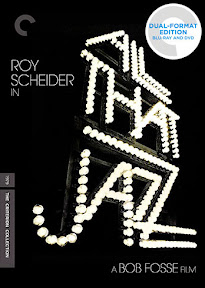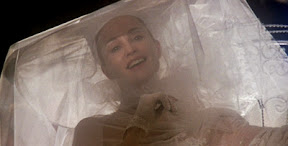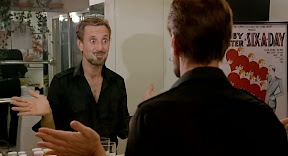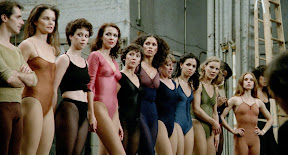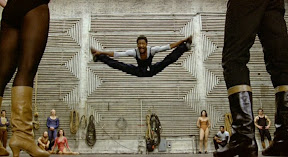“Don’t panic on the stairs,” Ann Reinking’s Katie urges her boyfriend’s daughter Michelle (Erzsebet Foldi) moments before the two perform for Bob Fosse’s on-screen stand-in Joe Gideon (played by Roy Scheider) in his semi-autobiographical Palme d’or winner All That Jazz.
Yet while Katie was merely reminding the young girl to be confident and keep it together during a dance, this same ‘show must go on’ mentality permeates throughout Fosse’s Felliniesque musical which pulsates with life despite being made after the co-writer/director’s own brush with death (from a cardiac ailment that would eventually kill him).
But far from the hospital prescribed ‘stop and smell the roses’ slow-going waltz-like rhythm that you would expect a heart attack survivor to follow, Jazz taps along at the frantic pace of a man who takes life three steps at a time while spending his days and nights in the cross-section of Broadway and Hollywood in the city that never sleeps.
Directing a stage show and cutting a film, Gideon is so out of breath from the speed of life (and the speed he pops like breath mints) that he coughs his way from one scene to the next – a chain-smoked cigarette dangling from his lips, an interchangeably nameless girl in his bed, and/or a bottomless drink in his hand throughout the course of the film.
Unable to slow down even when hospitalized, the film (which uses Fellini’s 8 ½ as a blueprint but in all reality plays most effectively as both a thematic and stylistic companion piece to Fosse’s Lenny Bruce biopic Lenny) states its thesis mere moments into its bravura opening sequence.
“To be on the wire is life; the rest is waiting,” Gideon tells the often veiled “angel of death” character played by Jessica Lange, who seems to exist in a limbo-like hallucinatory state to the man who is on the verge of a complete mental, physical, and psychological breakdown that might indeed kill him by the time the final credits roll.
And although he admits that the line didn’t originate with him, given the way it rolls off his tongue as easily and believably as his man-in-the-mirror morning mantra of “It’s showtime!” or any of the lies he tells in spite of warning others that they “can’t bullshit a bullshitter,” it’s arguably one of the most genuine statements he makes during Jazz's entire running time.
Moreover, given the picture's "art is life” arguments and the biblical allusions that exist throughout (including his surname), whether the wire equals “showtime” – which essentially doubles as the real world for Gideon who’s only “off” when he’s asleep – or whether it has a more philosophical or spiritual meaning is anyone's guess.
As such, it's a film that begs to be explored and then debated as it simultaneously roasts and salutes the institutions it touches upon such as religion, medicine, show business, family, and more.
Yet while it's hard to feel that much empathy toward not only the lead but also some of the characters who seem to act as Gideon's doormats that he gladly steps upon while running up the stairs to reach the wire and/or take center stage, once you look past the work's overindulgent pretensions, there's a lot to admire about Jazz from an artistic perspective.
A technically groundbreaking effort, Jazz pushes the limits of genre filmmaking to the point where music is made by way of the cinematic medium alone.
Perhaps most impressively in Jazz, non-performance scenes are as just hypnotic as some of Jazz's greatest traditional numbers, including Reinking and Foldi's scene-stealer "Everything Old is New Again," where in a tribute to Gideon they hop on his apartment's stairs two at a time to the beat of the Peter Allen tune.
From fragmented lines of dialogue placed on top of rhythmic cuts of repetitive visuals, All That Jazz serves up unexpected juxtapositions to create ironic counterpoints about art, medicine and commerce as Fosse – together with his ingenious Lenny editor Alan Heim – continue to experiment with Avant-garde montage techniques to expressionistic effect.
Admittedly, however it’s an awful lot to take in and Jazz’s emphasis on style over content shortchanges the postmodern picture's emotional impact as it’s hard to understand or care much about the unlikable Gideon as anything other than a Fosse substitute.
Nonetheless the film keeps us fascinated even when it starts to go gloriously wrong, falling off from its perch on the high wire before tumbling into an over-the-top final act filled with excess and ego run amok.
While in my eyes, it isn’t nearly as successful as Fosse’s brilliant Sweet Charity follow-up Cabaret which not only garnered him his first Academy Award but found him beating Godfather filmmaker Francis Ford Coppola in the directorial Oscar category, the impact of All That Jazz’s release on the cusp of the music video generation cannot be understated.
From the Fosse-lite film adaptation of A Chorus Line to the frequent toe-tapping jump-cuts in Footloose not to mention Michael Jackson’s early videos and top-hat and glove wearing persona in general, Jazz’s legacy has grown even stronger in the past two decades with the resurgence of Fosse-nostalgic musicals like Chicago and in non-musical features alike.
With regard to the latter, perhaps its most iconic sequence is its most cinematically influential as Gideon’s "showtime" morning routine has inspired similar sequences of rhythmic repetition in a wide array of diverse films including Requiem for a Dream, Marie Antoinette, and The Wolf of Wall Street.
Likewise given the way that Heim’s clever counterpoints have been endlessly paid homage to again and again – showing up so frequently that some filmmakers might not even be aware of the original source material – it’s certainly fitting that Jazz was inducted into the National Film Registry at the Library of Congress as a treasured work of artistic importance.
Although I was surprised to see it restored and showcased as part of The Criterion Collection before Fosse's masterful Cabaret, my hope is that this is just the first of at least three other Fosse titles given the Criterion treatment.
And this is especially vital considering not only the Lenny like film that Gideon is working on in Jazz but Heim and Fosse’s continued efforts to take their dance-like editing efforts even further this time around, which sets up Jazz as a perfect double feature to play before or (preferably) after the Dustin Hoffman starring Lenny.
While the booklet included with the dual format set (comprised of one gorgeous Blu-ray and two jam-packed DVDs) is a bit underwhelming when contrasted with the historical and biographical detail included in recent Criterion releases, the title is loaded with archive worthy treasures including vintage and current interviews, featurettes, and documentaries.
Even though the film moves at Gideon’s breakneck speed, hurtling you high into the air before sending you tumbling down the staircase, the Criterion set offers you enough surprises to pour over after that – in taking a cue from Reinking’s Katie – you should avoid panic and take a leisurely approach, visiting each extra while taking the titles one step at a time.
Text ©2014, Film Intuition, LLC; All Rights Reserved. http://www.filmintuition.com Unauthorized Reproduction or Publication Elsewhere is Strictly Prohibited and in violation of the Digital Millennium Copyright Act. FTC Disclosure: Per standard professional practice, I may have received a review copy of this title in order to evaluate it for my readers, which had no impact whatsoever on whether or not it received a favorable or unfavorable critique.
